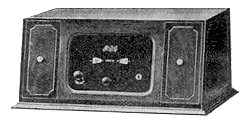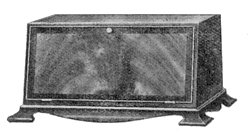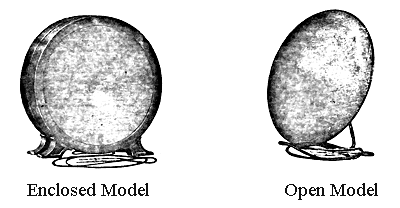Electronic Products for 1926 to 1928
| 1926 saw the introduction of the Symphony range of
receivers, which featured simpler tuning, fewer controls,
and a neater appearance, with no external valves, coils, or
resistors. The product range also included the first A.J.S.
superhets, which were produced so that the company could
compete with the fierce competition. The receivers included
cheap T.R.F. models with simple tuning, and more expensive
superhets that gave a much better performance.
The days of
headphone reception were over as all of the receivers came
with loudspeakers. The more sensitive ones also came with
frame aerials so that an outdoor aerial was no longer a
necessity. The receivers were housed in either table top
cabinets or free standing bureau models. There was also a
portable T.R.F. receiver that had a built-in loudspeaker and
frame aerial. This range of receivers continued in
production until 1928, when radio production ceased. |

The 'Symphony Two', and 'Symphony Three' table-top
receiver. The cabinet was made of mahogany. Photo courtesy of
John Chapman. |
|
The 'Symphony Two' was a 2 valve T.R.F.
receiver, that was housed in a mahogany table-top cabinet. It
sold for £17.10s.0d. The price included a 'Junior' horn
loudspeaker and batteries.
The 'Symphony Three' was a 3 valve T.R.F. receiver,
that was also housed in a mahogany table-top cabinet. It sold
for £25, and included a 'Standard' horn loudspeaker and
batteries. In both models the batteries were housed inside the
cabinet, behind the doors.
|
| The 'Symphony Five' was a 5 valve superhet and
was available in either a table-top or bureau style cabinet.
The receiver came complete with a 'Standard' horn
loudspeaker and batteries. The table-top model sold for £45,
and the bureau model was £52.10s.0d.
The 'Symphony Seven' was a 7 valve superhet and was available
in either a table-top or bureau style cabinet. The receiver came
complete with a 'Standard' horn loudspeaker, 2 frame aerials and
batteries. The table-top model sold for £60, and the bureau
model was £67.10s.0d.
The bureau cabinet included a battery compartment below the
receiver. The batteries were accessible behind the two doors on
the front. |

The Symphony 5 bureau receiver. The
cabinet was made of mahogany. Photo courtesy of John
Chapman. |
 |
The 'Symphony Five' table
model.
Photo courtesy of John Chapman. |
| The frame aerials were also available separately,
and were made in two versions. One was for long
wave and the other was for medium wave. Each version
sold for £2.10s.0d.
The last model was the 'Symphony Five' portable model. This
was a 5 valve T.R.F. receiver that was housed in a small oak
cabinet with a carrying handle. The cabinet also housed a moving
iron loudspeaker, frame aerial and batteries.
There was a single
tuning control, a long wave / medium wave, waveband switch, and
a volume control. The receiver weighed 26.5lbs, and sold for
£22.10s.0d.
|

The 'Symphony Seven' with frame aerial.
Photo courtesy of John Chapman. |
 |
The A.J.S. 'Standard'
loudspeaker from the Symphony catalogue. It was
available with Oak or Mahogany wood flares and sold
for £4.15s.0d.
Photo courtesy of John Chapman. |
| A.J.S. also produced two models of reed type
loudspeakers with a card cone. They were the
enclosed model in an attractive wooden case,
which sold for £3.10s.0d., and the open model
which sold for £1.15s.0d. |

| A.J.S.
Symphony 'Cone Reproducers'.
Courtesy of Joris
Van Campenhout. |
|
|

|
|
Return to A.J.S.
Receivers |
|

